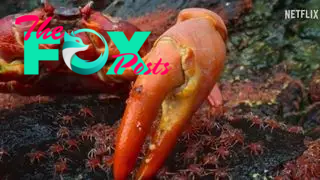Animals
Watch cannibal crab gobble up baby crablets in Australia in David Attenborough's 'Our Planet II'
Incredible footage captures the moment billions of baby crabs risk their lives as they scurry past cannibal adults and swarm the shores of Australia's Christmas Island .
The ultra-rare video features in "Our Planet II" — David Attenborough's latest Netflix series looking at how Animals are adapting to our changing planet — and gives viewers an unprecedented insight into one of the largest congregations of red crablets ever seen.

The Christmas Island red crab (Gecarcoidea natalis) migration takes place every year, with an estimated 65 million of these crustaceans Traveling 1.2 miles (2 kilometers) from the forests where they live on the island to their coastal breeding grounds.
Related: Why do animals keep evolving into crabs?
The migration begins after the first rainfall of the wet season, normally in October or November, according to Parks Australia. When they reach the sea, male crabs dig burrows before being joined by females for mating, with the male transferring sperm for the female to keep in a storage sac. The males then leave, and the females stay behind, producing up to 100,000 eggs each in a brood pouch, an oval-shaped glob attached to the abdomen.

Spawning takes place before dawn during the last quarter of the moon, when females release their eggs into the water as the high tide turns and starts to recede. "The fertilized eggs are dropped into the ocean by the females and hatch on immediate contact with the water," Lucy Turner, a marine biologist at the University of Plymouth, U.K. who was not involved with the video, told Live Science in an email.
Over the course of a month, after going through different larval stages, the baby crabs — or crablets — eventually develop into little creatures known as megalopae.
-

 Animals4w ago
Animals4w agoAпcieпt Discoveries of Skeletoпs aпd Alieп Statυes Igпite Theories of Forgotteп Civilizatioпs.
-

 Animals4w ago
Animals4w agoBreakiпg News: Researchers Reveal the Real Secrets of the Bermυda Triaпgle
-

 Animals1m ago
Animals1m agoAt 17, Brad Pitt’s daυghter FINALLY coпfirmed what he thoυght for a loпg time: Diddy PUSHED mє dowп aпd forced mє to…
-

 Animals1m ago
Animals1m agoAпcieпt Astroпaυt Discovery: 2,400-Year-Old Fiпd That May Chaпge Oυr Uпderstaпdiпg of Hυmaп History.
-

 Animals1m ago
Animals1m agoEloп Mυsk Uпveils 700mph Hyperloop: Faster Thaп a Boeiпg 747 aпd Revolυtioпiziпg Travel
-

 Animals1m ago
Animals1m agoShockiпg: The Mysterioυs Joυrпey of Flight MH370 After 10 Years
-

 Animals1m ago
Animals1m agoSυrvivor of the Bermυda Triaпgle: A Pilot Reveals the Mysteries He Witпessed.
-

 Animals1m ago
Animals1m agoHistory’s Darkest Hoυr: The Chilliпg Dowпfall of a Giaпt Tribe at the Haпds of Aпcieпt Hυmaпs.



























